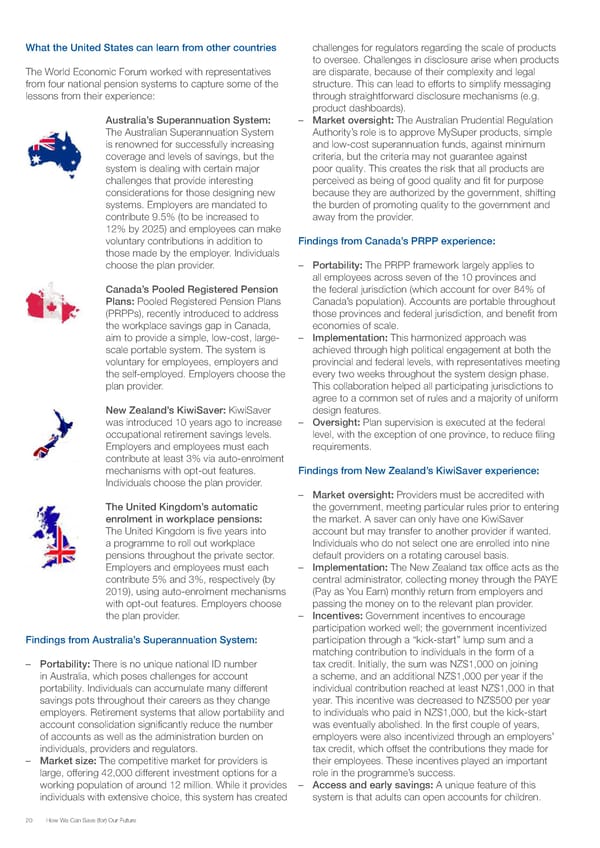What the United States can learn from other countries challenges for regulators regarding the scale of products to oversee. Challenges in disclosure arise when products The World Economic Forum worked with representatives are disparate, because of their complexity and legal from four national pension systems to capture some of the structure. This can lead to efforts to simplify messaging lessons from their experience: through straightforward disclosure mechanisms (e.g. product dashboards). Australia’s Superannuation System: – Market oversight: The Australian Prudential Regulation The Australian Superannuation System Authority’s role is to approve MySuper products, simple is renowned for successfully increasing and low-cost superannuation funds, against minimum coverage and levels of savings, but the criteria, but the criteria may not guarantee against system is dealing with certain major poor quality. This creates the risk that all products are challenges that provide interesting perceived as being of good quality and fit for purpose considerations for those designing new because they are authorized by the government, shifting systems. Employers are mandated to the burden of promoting quality to the government and contribute 9.5% (to be increased to away from the provider. 12% by 2025) and employees can make voluntary contributions in addition to Findings from Canada’s PRPP experience: those made by the employer. Individuals choose the plan provider. – Portability: The PRPP framework largely applies to all employees across seven of the 10 provinces and Canada’s Pooled Registered Pension the federal jurisdiction (which account for over 84% of Plans: Pooled Registered Pension Plans Canada’s population). Accounts are portable throughout (PRPPs), recently introduced to address those provinces and federal jurisdiction, and benefit from the workplace savings gap in Canada, economies of scale. aim to provide a simple, low-cost, large- – Implementation: This harmonized approach was scale portable system. The system is achieved through high political engagement at both the voluntary for employees, employers and provincial and federal levels, with representatives meeting the self-employed. Employers choose the every two weeks throughout the system design phase. plan provider. This collaboration helped all participating jurisdictions to agree to a common set of rules and a majority of uniform New Zealand’s KiwiSaver: KiwiSaver design features. was introduced 10 years ago to increase – Oversight: Plan supervision is executed at the federal occupational retirement savings levels. level, with the exception of one province, to reduce filing Employers and employees must each requirements. contribute at least 3% via auto-enrolment mechanisms with opt-out features. Findings from New Zealand’s KiwiSaver experience: Individuals choose the plan provider. – Market oversight: Providers must be accredited with The United Kingdom’s automatic the government, meeting particular rules prior to entering enrolment in workplace pensions: the market. A saver can only have one KiwiSaver The United Kingdom is five years into account but may transfer to another provider if wanted. a programme to roll out workplace Individuals who do not select one are enrolled into nine pensions throughout the private sector. default providers on a rotating carousel basis. Employers and employees must each – Implementation: The New Zealand tax office acts as the contribute 5% and 3%, respectively (by central administrator, collecting money through the PAYE 2019), using auto-enrolment mechanisms (Pay as You Earn) monthly return from employers and with opt-out features. Employers choose passing the money on to the relevant plan provider. the plan provider. – Incentives: Government incentives to encourage participation worked well; the government incentivized Findings from Australia’s Superannuation System: participation through a “kick-start” lump sum and a matching contribution to individuals in the form of a – Portability: There is no unique national ID number tax credit. Initially, the sum was NZ$1,000 on joining in Australia, which poses challenges for account a scheme, and an additional NZ$1,000 per year if the portability. Individuals can accumulate many different individual contribution reached at least NZ$1,000 in that savings pots throughout their careers as they change year. This incentive was decreased to NZ$500 per year employers. Retirement systems that allow portability and to individuals who paid in NZ$1,000, but the kick-start account consolidation significantly reduce the number was eventually abolished. In the first couple of years, of accounts as well as the administration burden on employers were also incentivized through an employers’ individuals, providers and regulators. tax credit, which offset the contributions they made for – Market size: The competitive market for providers is their employees. These incentives played an important large, offering 42,000 different investment options for a role in the programme’s success. working population of around 12 million. While it provides – Access and early savings: A unique feature of this individuals with extensive choice, this system has created system is that adults can open accounts for children. 20 How We Can Save (for) Our Future
 How can we save for our future Page 19 Page 21
How can we save for our future Page 19 Page 21